Plants bring a touch of nature indoors and can be especially beneficial for seniors, adding greenery and a sense of calm to their living spaces.
Benefits of Gardening for Seniors
Houseplants can improve air quality, reduce stress, and provide a sense of accomplishment. If you’re gardening either indoors or outdoors, it’s a therapeutic activity that connects you with nature and provides a break from the hustle and bustle of daily life. And, if you’re outside, you can soak up some much-needed Vitamin D!
Easy Indoor and Outdoor Plants Best for Puyallup’s Climate
For those in senior care communities like The Rivers at Puyallup, selecting easy-to-care-for plants that thrive in Washington’s climate can be simpler than you expect. These types of vegetation can do well with just a bit of attention.
Boston Fern
The Boston fern is beloved for its feathery fronds that arch gracefully, creating a vibrant green canopy perfect for hanging baskets or pedestals. Its airy foliage gives indoor spaces a refreshing, natural look.
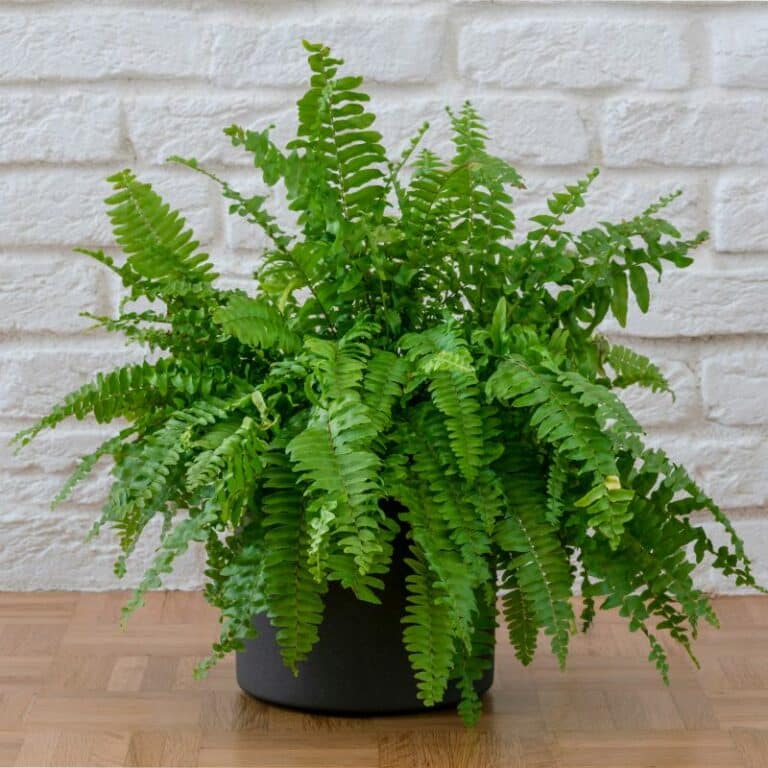
- Scientific name: Nephrolepis exaltata
- Other common names: sword fern, boss fern, and ladder fern
- Care information: Boston ferns prefer indirect light and high humidity. Keep the soil consistently moist, but ensure proper drainage. Browning leaves can indicate low humidity or underwatering.
Cast Iron Plant
This plant earns its name with tough, leathery dark green leaves that can withstand neglect and low light conditions. Its robust nature and upright growth make it a resilient choice for adding greenery to indoor environments where other plants may struggle.
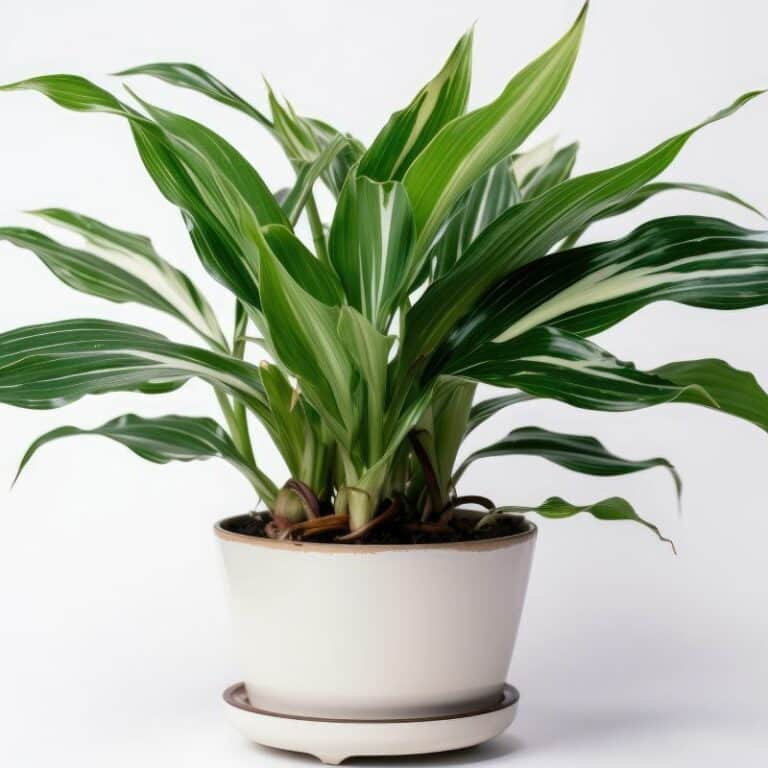
- Scientific name: Aspidistra elatior
- Other common name: bar-room plant
- Care information: Cast iron plants are extremely hardy, tolerating low light and infrequent watering. Water when the top couple of inches of soil are dry. Browning leaf tips show that the plant is too dry or exposed to drafts.
Chinese Evergreen Plant
The Chinese evergreen features broad, glossy leaves often adorned with striking patterns of green, silver, or white variegation. This plant is prized for its adaptability to low light and its ability to purify indoor air, making it a popular choice for homes and care communities alike.
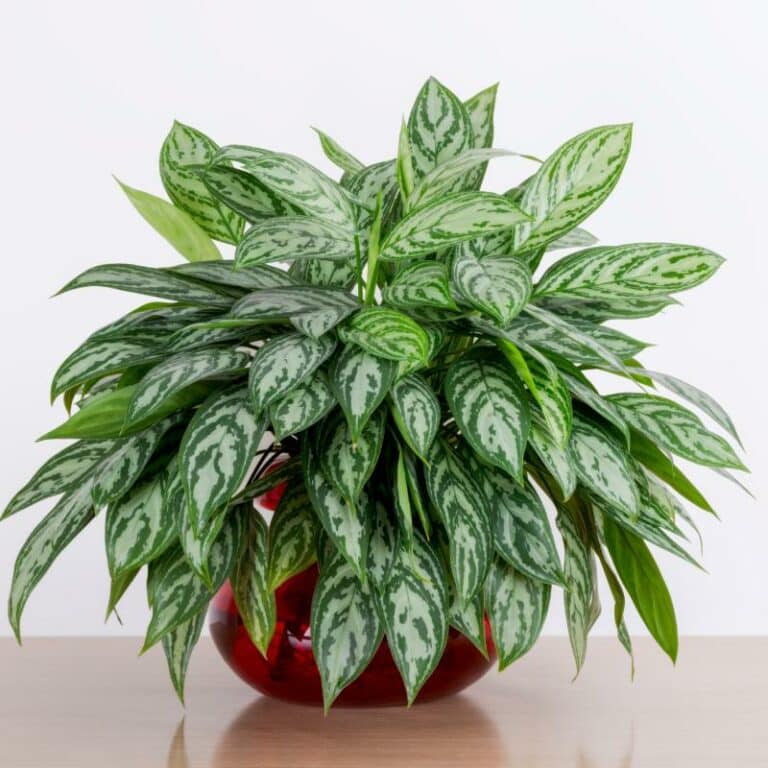
- Scientific name: Aglaonema commutatum, Aglaonema modestum, Aglaonema pictum, and other species in the Aglaonema genus
- Other common names: red Aglaonema, red valentine, and camouflage plant, depending on the type
- Care information: This plant does well in low to medium light and moderate watering. Let the top inch of soil dry out before watering. Yellow leaves are a sign of too much water or light.
Oak Leaf Plant
Resembling oak leaves with deeply lobed edges and prominent veins, typically in shades of green, the oak leaf plant’s unique foliage adds texture and interest to many arrangements.
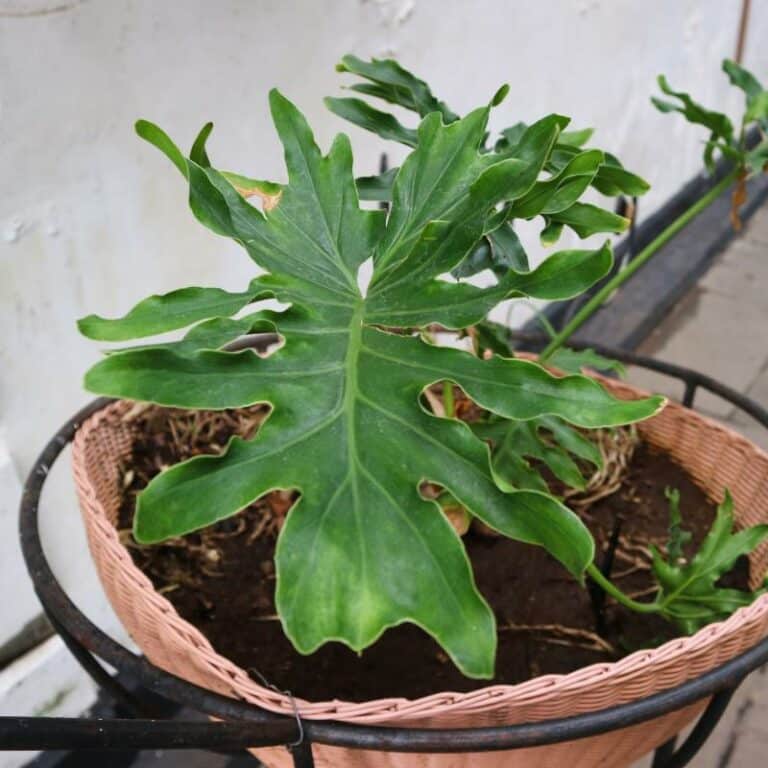
- Scientific names: Philodendron bernardopazii, Philodendron billietiae, Philodendron bipennifolium, and other species in the Philodendron genus
- Other common names: horsehead and fiddleleaf Philodendron, depending on the type
- Care information: The oak leaf plant adapts well to low light conditions with moderate watering. Allow the top inch of soil to dry out between waterings. Yellow leaves suggest overwatering, while brown leaf tips signal underwatering.
Peace Lily Plant
The peace lily plant is known for its dark green foliage and elegant white spathes that rise above the leaves, creating a serene and tropical atmosphere indoors.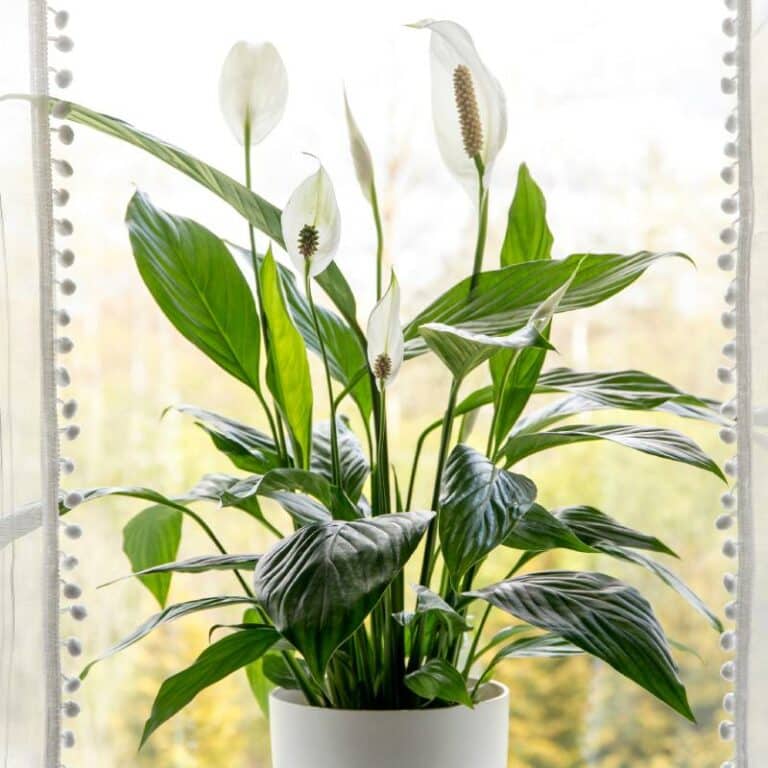
- Scientific names: Spathiphyllum floribundum, Spathiphyllum wallisii, and other species in the Spathiphyllum genus
- Other common names: white sails and spath flower, depending on the type
- Care information: Place your peace lily in low to medium light with consistent moisture. Water when the top inch of soil is dry, but don’t let it sit in water. Drooping leaves show that it needs water, while yellow leaves signify overwatering.
Parlor Palm
The parlor palm is characterized by its delicate, feathery fronds that arch gracefully from a central stem. Compact and well-suited for indoor environments, it adds a touch of tropical elegance to spaces.
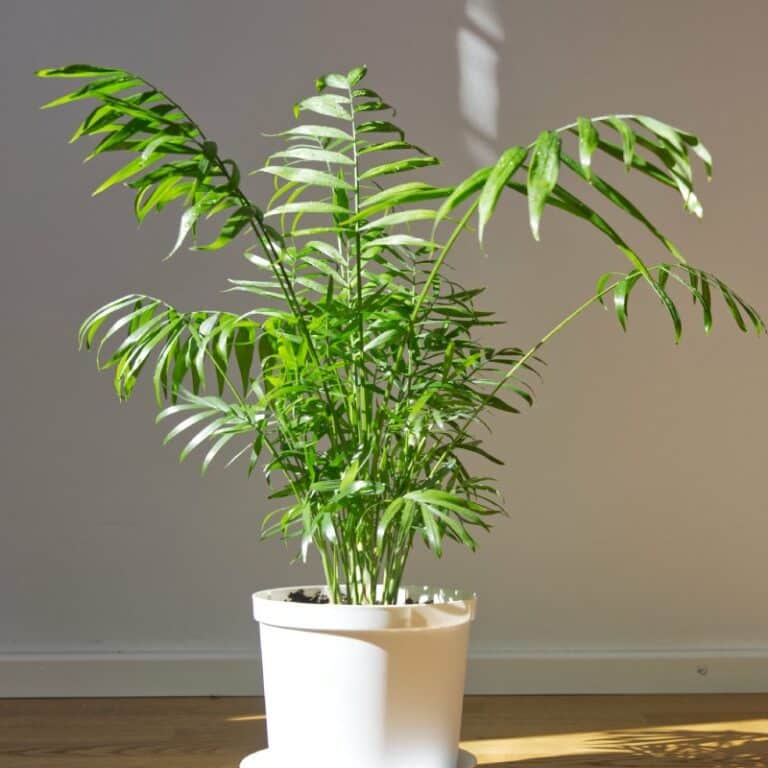
- Scientific name: Chamaedorea elegans
- Other common name: Bella palm
- Care information: It prefers low to medium light and requires moderate watering. Allow the soil to dry out slightly between waterings. Yellowing leaves can reveal overwatering, while brown leaf tips are a result of underwatering.
Plants That Thrive Anywhere Indoors Across the United States
In a climate like Washington’s, where the outdoor gardening season can be short due to cooler, wetter weather, many seniors prefer indoor plants.
Air Plant
Air plants, known for their ability to grow without soil, feature thin, wiry leaves that often curl or twist into unique shapes. They absorb moisture and nutrients through their leaves, making them versatile for creative displays in terrariums or hanging planters.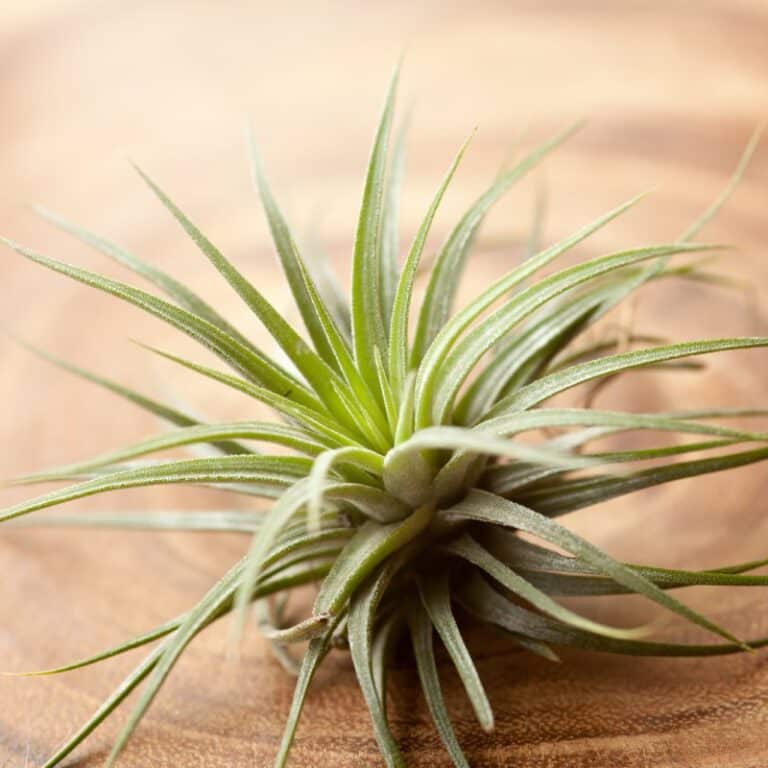
- Scientific names: Tillandsia streptophylla, Tillandsia usneoides, Tillandsia ionantha, and other species in the Tillandsia genus
- Other common name: Shirley Temple
- Care information: Soak in water for about 30 minutes every few weeks and let them dry upside down. Mist every few days, especially in low humidity. Keep them in shaded spots away from direct sunlight. Ensure they dry out completely after soaking to prevent rot.
Aloe Plant
This is a succulent with thick, fleshy leaves that store water, characterized by serrated edges and sometimes reddish hues on the leaf margins. It thrives in bright light and well-draining soil, with occasional watering.
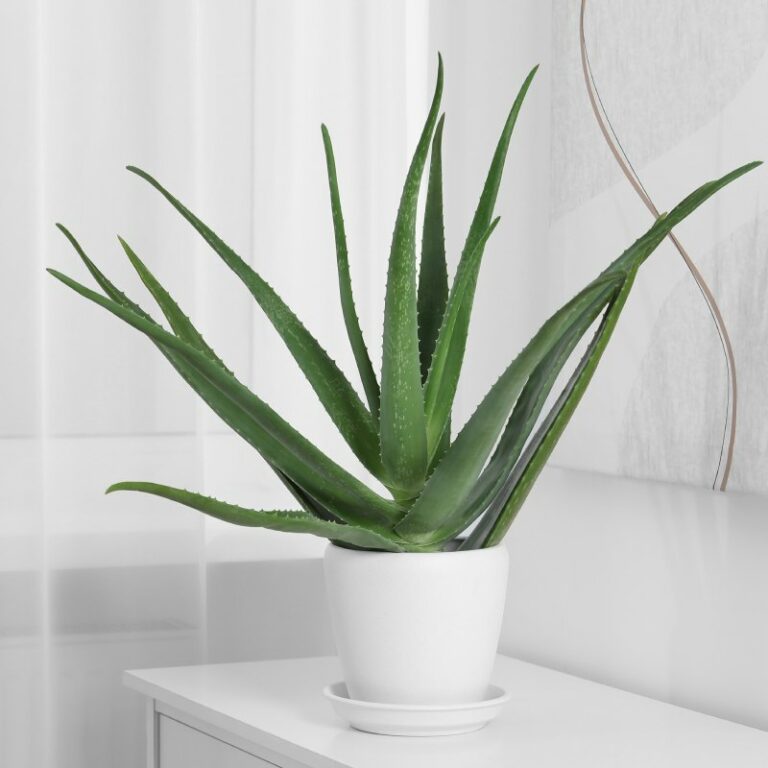
- Scientific name: Aloe barbadensis miller
- Other common name: Aloe vera
- Care information: Use a cactus potting mix and place your aloe plant near a sunny window. Ensure the pot has excellent drainage and water thoroughly, then let the soil dry out completely before watering again. Wilting leaves indicate under-watering, while yellow leaves suggest overwatering.
English Ivy Plant
The English ivy showcases small, dense leaves that grow profusely, often trailing or climbing surfaces. It adds a lush, green backdrop to indoor senior homes and apartments.
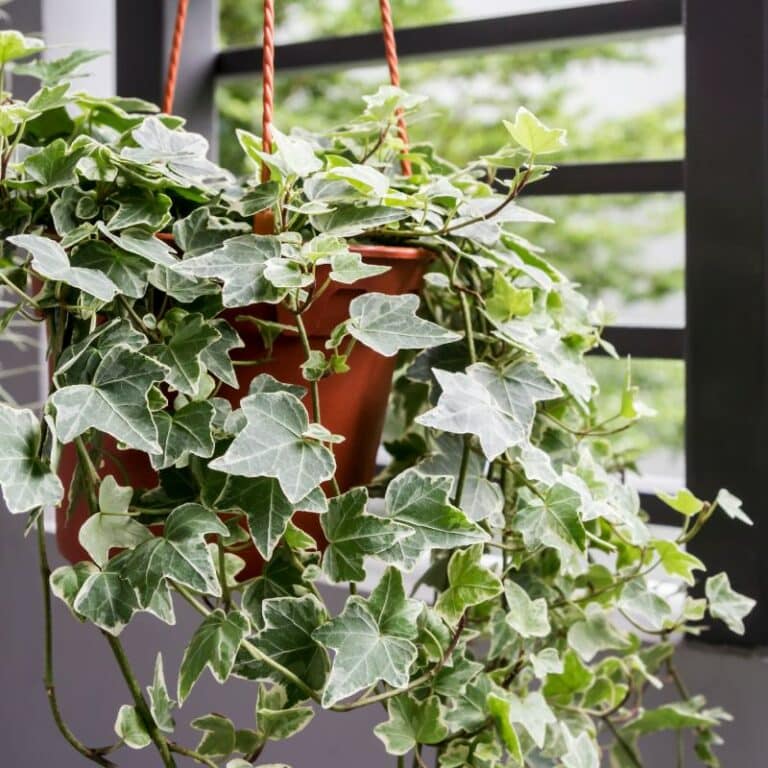
- Scientific name: Hedera helix
- Other common names: California ivy, common ivy, and sweetheart ivy
- Care information: English ivies prefer bright, indirect light but can tolerate low light. Keep the soil moist but not soggy, and prune often. Dry, brittle leaves are signs of under-watering; yellowing leaves can signify overwatering.
Jade Plant
A classic succulent, the jade plant features thick, oval-shaped leaves that are glossy and often tinged with red along the edges. Its compact size and resilient nature make it a popular choice for indoor gardens.
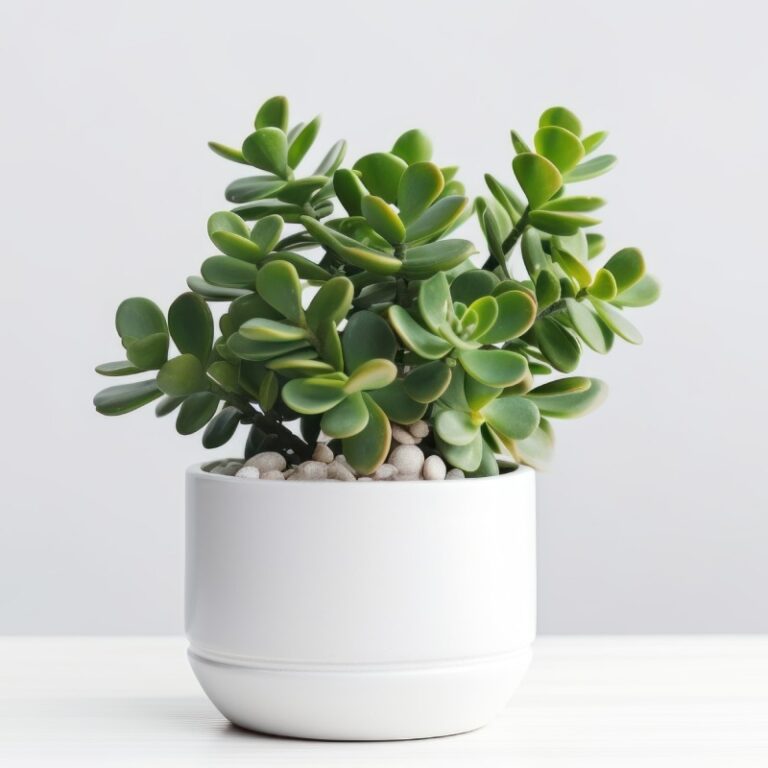
- Scientific name: Crassula ovata
- Other common names: lucky plant, friendship plant, and dollar plant
- Care information: It prefers bright light but can tolerate low light. Water when the top inch of soil is dry, but be careful not to overwater. Wrinkled leaves are evidence of under-watering, while yellowing leaves are from overwatering.
Lucky Bamboo Plant
Despite its name, “lucky bamboo” is not bamboo, but rather a dracaena species grown in water or soil. It’s recognized for its slender, upright stalks and is often associated with good luck and prosperity in many cultures.
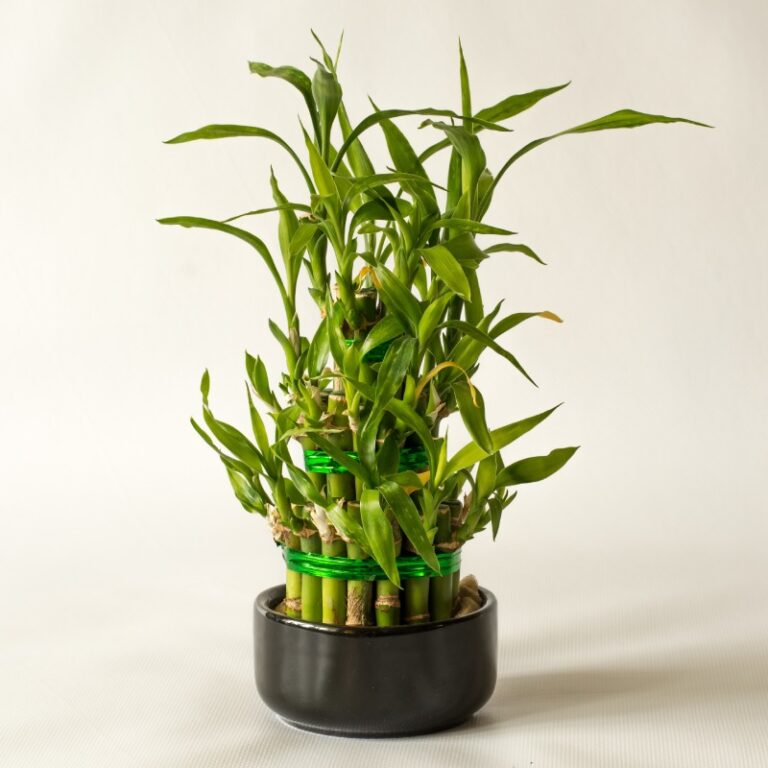
- Scientific name: Dracaena sanderiana
- Other common names: curly bamboo and Chinese water bamboo
- Care information: Grow the lucky bamboo plant in water or soil under low to medium light. If growing in water, change the water every two to four weeks. Yellowing leaves are a sign of poor water quality or too much direct sunlight.
Pothos
The Pothos is distinguished by heart-shaped leaves that are variegated with shades of green, yellow, or white. It’s highly adaptable and capable of trailing or climbing as it grows.
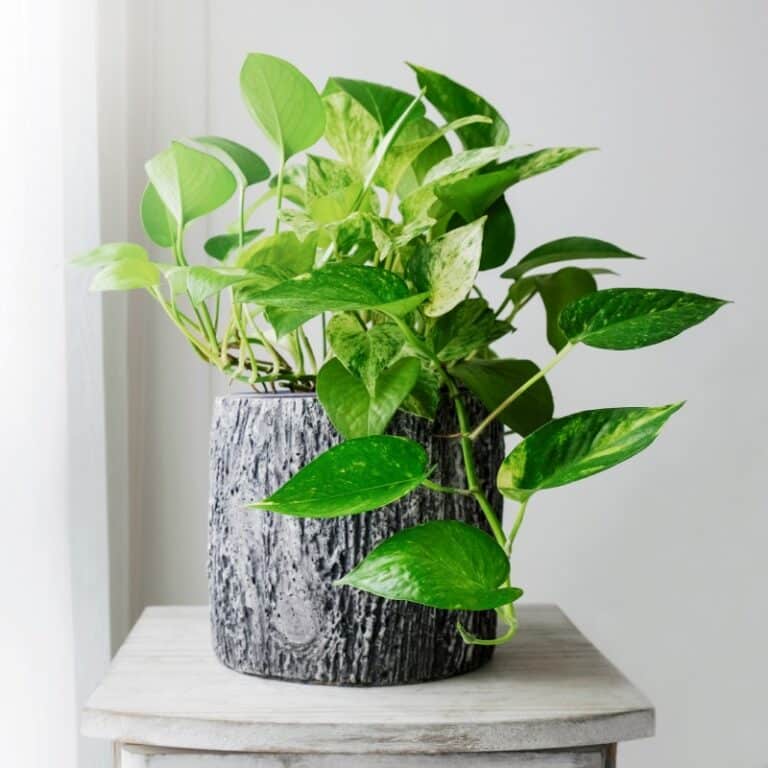
- Scientific name: Epipremnum aureum
- Other common name: Devil’s ivy
- Care information: Pothos require minimal light and should be watered sparingly. Allow the soil to dry out between waterings to prevent root rot. Drooping leaves after watering may mean it’s time to repot.
Rubber Plant
The rubber plant is known for its large, thick, and glossy leaves that are typically dark green. Its bold foliage and upright growth make it a statement piece indoors.
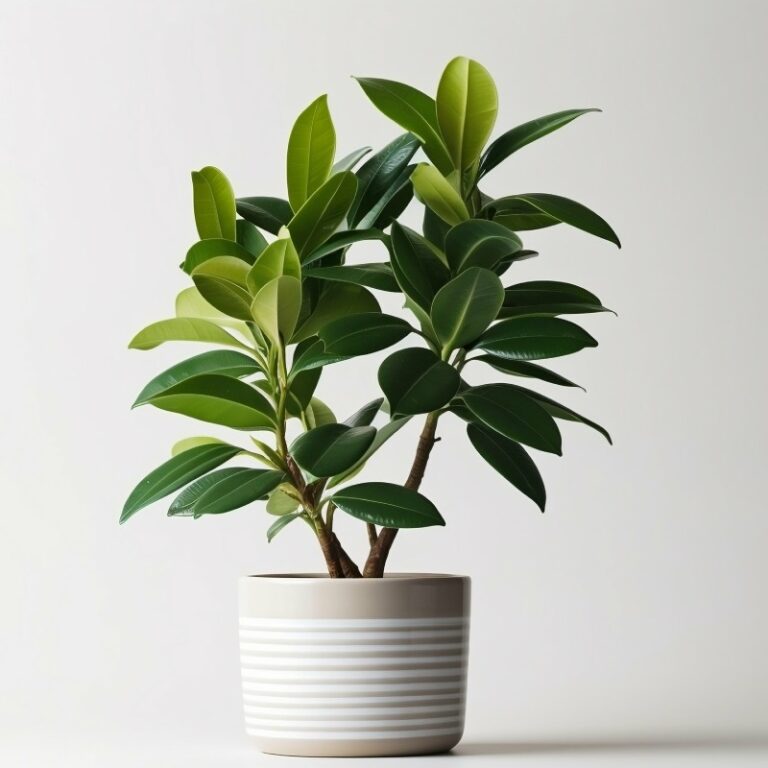
- Scientific name: Ficus elastica
- Other common names: Rubber tree, rubber fig, Indian rubber tree, Indian rubber bush
- Care information: Expect the plant to flourish in bright, indirect light but can adapt to lower light conditions. Water when the top inch of soil is dry. Drooping leaves suggest both under-watering and overwatering.
Snake Plant
With its upright, sword-like leaves that can be mottled with shades of green and yellow, the snake plant is renowned for its air-purifying properties and low maintenance.
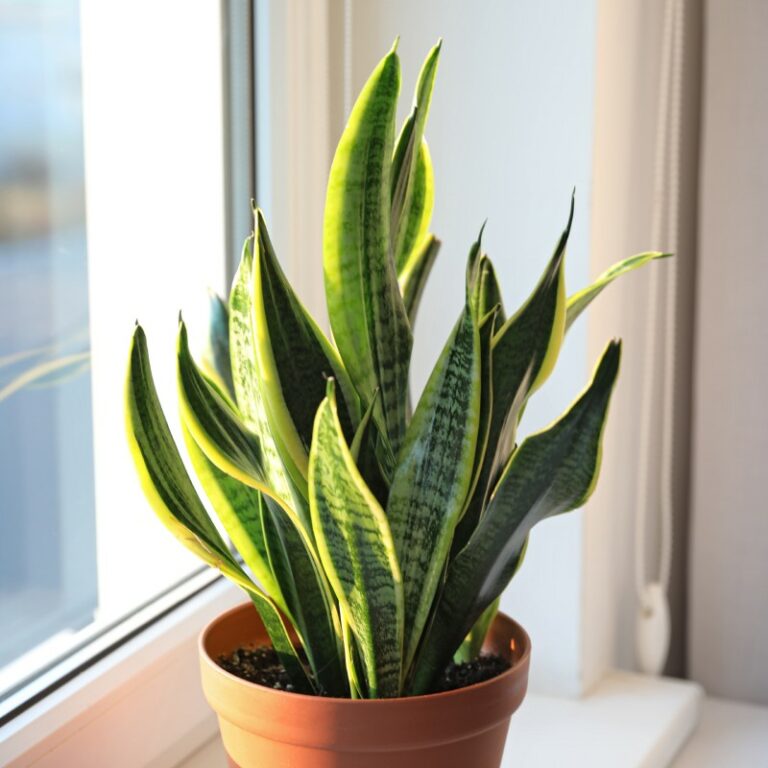
- Scientific name: Sansevieria trifasciata
- Other common name: Saint George’s sword
- Care information: It prefers indirect light and minimal watering. Let the soil dry out completely between waterings and reduce watering in winter. Yellow, droopy leaves and a bad smell can be an indication of overwatering.
Spider Plant
The spider plant is distinguished by its arching leaves striped with green and white, producing small plantlets at the ends of long, slender stems. It’s well-suited for hanging baskets.
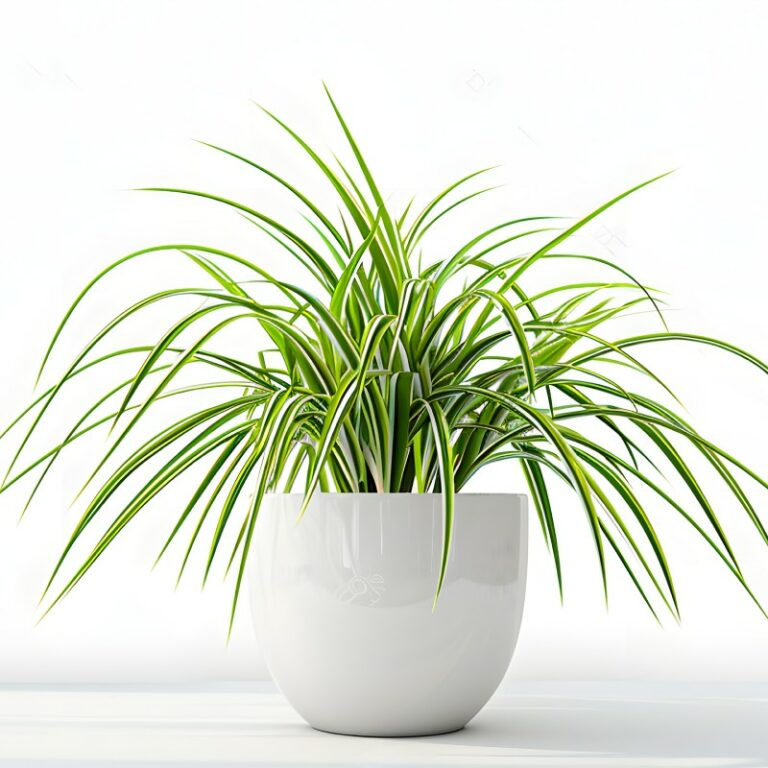
- Scientific name: Chlorophytum comosum
- Other common name: Airplane plant
- Care information: Spider plants are best for bright, indirect sunlight but can tolerate low light. Water when the top two inches of soil are dry and reduce watering in winter. Avoid cold drafts. Droopy leaves signify underwatering, while yellow or soft brown leaves show overwatering.
ZZ Plant
This unique type of greenery features glossy, waxy leaves that grow upright in a graceful manner, making it a popular choice for minimalist interiors.
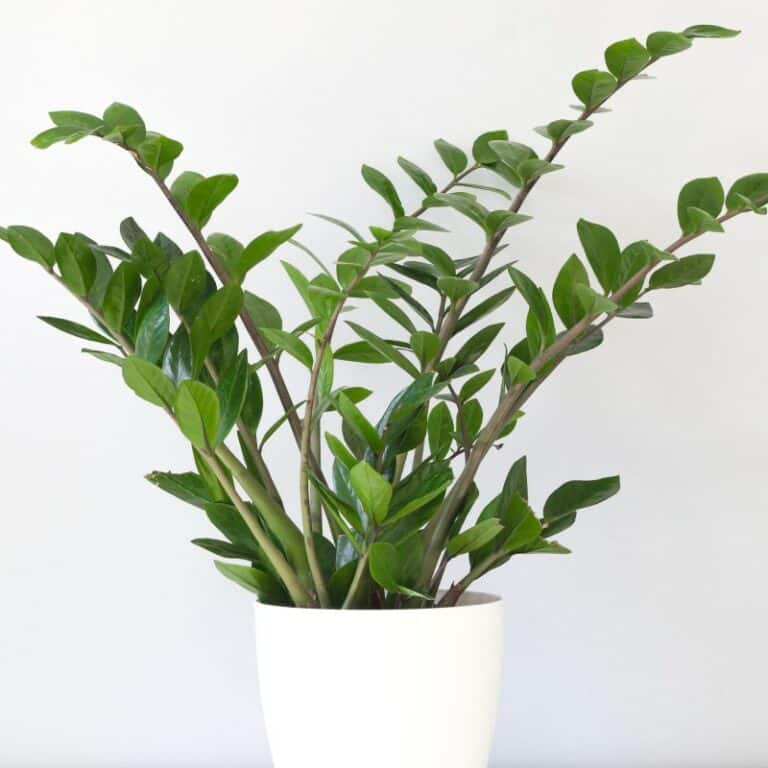
- Scientific name: Zamioculcas zamiifolia
- Other common name: Aroid palm
- Care information: This type of plant is perfect for low-light areas and only needs watering when the soil is completely dry. Yellow leaves are a sign of overwatering.
Ready to Choose Plants When Decorating for Senior Living?
When selecting plants for anywhere in your local senior living space, remember to consider varieties that thrive in Washington’s climate with minimal maintenance. Options such as the Boston fern, cast iron, and Chinese evergreen are excellent because of their resilience, adaptability to a variety of conditions, and ease of care.
For seniors who prefer indoor gardening due to Washington’s short outdoor gardening season, versatile plants like air and aloe plants as well as English ivies thrive across various temperature-controlled environments. These plants not only tolerate different light conditions but also contribute to air quality.
Remember that some plants are poisonous for our furry friends! Check to make sure your new plants won’t interfere with the health of your pets.
Experience the Comforts of Gardening at The Rivers at Puyallup
Whether you’re cultivating lush indoor greenery or tending to outdoor blooms, gardening at The Rivers at Puyallup offers a fulfilling way to connect with nature and enhance your daily life. To learn more, contact our senior care team today!




